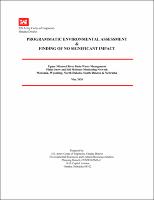Please use this identifier to cite or link to this item:
https://hdl.handle.net/11681/48213| Title: | Programmatic Environmental Assessment & Finding of No Significant Impact : Upper Missouri River Basin Water Management, Plains Snow and Soil Moisture Monitoring Network, Montana, Wyoming, North Dakota, South Dakota & Nebraska |
| Authors: | United States. Army. Corps of Engineers. Omaha District |
| Keywords: | Missouri River Watershed Hydrology Soil moisture Snow Remote sensing Environmental management Environmental protection |
| Publisher: | United States. Army. Corps of Engineers. Omaha District. |
| Abstract: | Following the 2011 flood event on the Missouri River, the Corps and an Independent Review Team comprised of academic experts and officials from various federal agencies, determined that the Corps substantially underestimated the wet soil conditions in the plains and the plains snowpack in its water supply forecasts. One finding from the 2013 Upper Missouri River Basin Monitoring Committee: Snow Sampling and Instrumentation Recommendations interagency report was to improve snowpack and soil moisture monitoring in the upper Missouri River basin, specifically Montana, North Dakota, South Dakota, Nebraska and Wyoming. This report described existing federal and state data collection networks (mesonet) in the upper Missouri River basin that provide some information about soil moisture or snowpack as well as existing data collection networks that do not currently collect data on soil moisture and/or snowpack but may be modified to do so. Currently, there are approximately 180 existing mesonet sites in seven networks in the upper Missouri River basin that collect soil moisture and snowpack data, or may be modified to collect these data. An estimated additional 360 sites are required in order to provide the necessary quality of data to better inform runoff forecasting. The data obtained from the network would be available for all federal, state and local agencies to use in the betterment of existing and new products for various efforts, such as river forecasting, flood outlooks, drought monitoring, water supply forecasts and fire hazard reporting. From December 2018 through July 2019, instrumentation and measurement techniques were conducted by climatologists with the South Dakota State University (SDSU) in Brookings, South Dakota on SDSU’s campus as funded by the Corps. This work was carried out in order to determine a variety of automated and manual observations to test the practicability and accuracy of different technologies before deployment of a full plains snowpack and soil moisture monitoring network in the UMB. Testbed experiments compared different technologies for measuring solar radiation, precipitation, snow depth, snow water equivalent and soil temperature and moisture. A summary of findings is in Section 3, and the complete SDSU Hydrologic Testbed Report may be found in Appendix B. Five proof-of-concept sites were proposed to be updated in late Spring 2020. Updating existing stations at SDSU, as well as at Montana State University in Bozeman, Montana and the University of Wyoming in Sheridan, Wyoming were assessed in the Pilot Study for the Upper Missouri River Basin Water Management Plains Snow and Soil Moisture Monitoring Network EA and Finding of No Significant Impact (FONSI) (February 2020). Monitoring stations updated in Carrington, North Dakota and Eagle, Nebraska were not federally funded and therefore not subject to NEPA. The intent of the proof-of-concept effort was to further inform equipment selection and installation methods in a mesocom study prior to implementation of a basin-wide scale. Updating the proof-of-concept monitoring stations is anticipated to be completed by late Summer 2020 so implementation of the basin-wide monitoring network could begin by late 2020. |
| Description: | Programmatic Environmental Assessment and Finding of No Significant Impact |
| URI: | https://hdl.handle.net/11681/48213 |
| Appears in Collections: | Environmental Documents |
Files in This Item:
| File | Description | Size | Format | |
|---|---|---|---|---|
| Plains Snow and Soil Moisture Monitoring Network PEA and FONSI _2020.pdf | 16.38 MB | Adobe PDF |  View/Open |